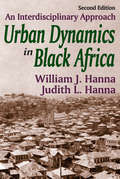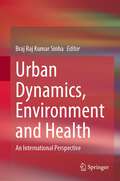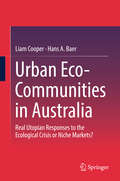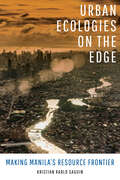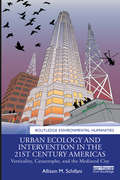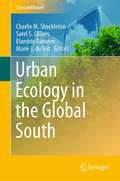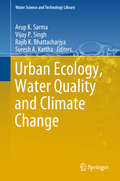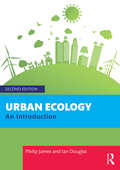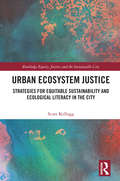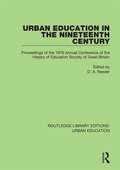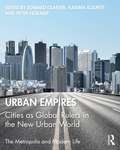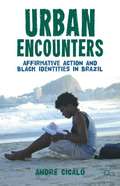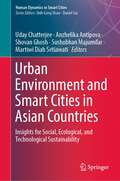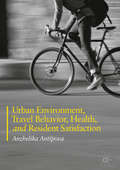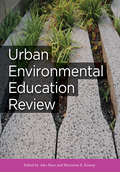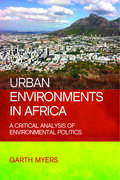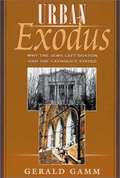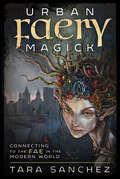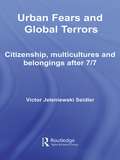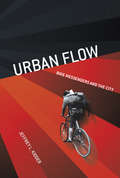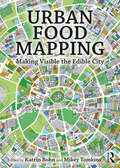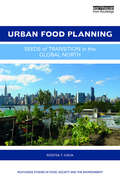- Table View
- List View
Urban Dynamics in Black Africa: An Interdisciplinary Approach
by William J. HannaUrban Dynamics in Black Africa presents a succession of worlds where we can study the development and the crystallization of major social change. The authors trace the development of former villages, towns, and colonial outposts into major cities within the international community. Open-air markets continue their trading beside modern department stores as individual Africans create contemporary lives from old and new.William J. and Judith L. Hanna, in this unique work, introduce new data and the methods of dependency theory, class and gender analysis; they offer connections between Africa's internal dynamics, its legacy of imperialism, and the international political and economic arena. At the same time, the book provides a model for studying the evolution of political institutions. Urban Dynamics in Black Africa illustrates how social classes modify and are modified by existing cultural forms. The book examines Africa in its independence by contrasting development and dependency, role adaptability and conflict, in a powerful conceptual matrix. Detailing the urban conditions that exist throughout Africa as well as their costs and benefits, this work shows how contemporary political conflict in urban Africa is based upon both ethnic and non-ethnic ties; and how these ethnic and non-ethnic ties serve as the bases of a system of political integration unique to poly-ethnic communities.As a synthesis of the relevant available knowledge on African towns and town-dwellers, this book is concerned primarily with the effects of external intervention and socioeconomic modernization upon the birth and development of Africa's new towns and the rapid expansion of its old ones. It considers the impact of migration and town life upon Africans.
Urban Dynamics, Environment and Health: An International Perspective
by Braj Raj Kumar SinhaThe comprehensive volume focuses on spatial, temporal, conceptual and empirical approaches to various elements of urban dynamics, environment and urban health. It demonstrates a multidisciplinary account of the significant dimensions of urbanization and urban life. Chapters by leading international experts are presented in sections on urban dynamics, Urban Environmental Issues, Urban Health Problems and Urban Development, Planning and Policies. Each chapter provides a breadth of information on conceptual and empirical studies of urban issues. It enables the readers to understand the interconnections of various vital elements of each urban-related topical issue locally, regionally and globally. Extensive maps, charts, diagrams and tables as cartographic tools facilitate the reader’s understanding. It also outlines an action plan for policy program change in both the developed and less developed countries toward sustainable urban development and environment for better health, prosperity and quality of life of the present and future urban population. It is an indispensable reference for students, research scholars of geography and environmental, medical, and social sciences at undergraduate and postgraduate levels.
Urban Eco-Communities in Australia: Real Utopian Responses to the Ecological Crisis or Niche Markets?
by Hans A. Baer Liam CooperThis book offers one of the first detailed anthropological studies of emergent ecotopianism in urban contexts. Engaging directly with debates on urbanisation, sustainability and utopia, it presents two detailed ethnographic case studies of inner urban Australian eco-communities in Adelaide and Melbourne. These novel responses to the ecological crisis – real social laboratories that attempt to manifest a vision of the ‘eco-city’ in microcosm – offer substantial new insights into the concept and creation of sustainable urban communities, their attempts to cultivate ways of living that are socially and ecologically nourishing, and their often fraught relationship to the capitalist city beyond. These studies also suggest the opportunities and limitations of moving beyond demonstration projects towards wider urban transformation, as well as exposing the problems of accessibility and affordability that thwart further urban eco-interventions and the ways that existing projects can exacerbate issues of gentrification and privilege in a socially polarised city. Amidst the challenges of the capitalist city, climate change and ecological crisis, this book offers vital lessons on the potential of urban sustainability in future cities.
Urban Ecologies on the Edge: Making Manila's Resource Frontier
by Kristian Karlo SaguinLaguna Lake, the largest lake in the Philippines, supplies Manila's dense urban region with fish and water while operating as a sink for its stormflows and wastes. Transforming the lake to deliver these multiple urban ecological functions, however, has generated resource conflicts and contradictions that unfold unevenly across space. In Urban Ecologies on the Edge, Kristian Karlo Saguin tracks the politics of resource flows and unpacks the narratives of Laguna Lake as Manila's resource frontier. Provisioning the city and keeping it safe from floods are both frontier-making processes that bring together contested socioecological imaginaries, practices, and relations. Combining fieldwork and historical accounts, Saguin demonstrates how people—powerful and marginalized—interact with the state and the environment to produce the unequal landscapes of urbanization at and beyond the city's edge.
Urban Ecology
by Kevin J. GastonThis is the urban century in which, for the first time, the majority of people live in towns and cities. Understanding how people influence, and are influenced by, the 'green' component of these environments is therefore of enormous significance. Providing an overview of the essentials of urban ecology, the book begins by covering the vital background concepts of the urbanisation process and the effect that it can have on ecosystem functions and services. Later sections are devoted to examining how species respond to urbanisation, the many facets of human-ecology interactions, and the issues surrounding urban planning and the provision of urban green spaces. Drawing on examples from urban settlements around the world, it highlights the progress to date in this burgeoning field, as well as the challenges that lie ahead.
Urban Ecology and Intervention in the 21st Century Americas: Verticality, Catastrophe, and the Mediated City (Routledge Environmental Humanities)
by Allison M. SchifaniThis book takes a hemispheric approach to contemporary urban intervention, examining urban ecologies, communication technologies, and cultural practices in the twenty-first century. It argues that governmental and social regimes of control and forms of political resistance converge in speculation on disaster and that this convergence has formed a vision of urban environments in the Americas in which forms of play and imaginations of catastrophe intersect in the vertical field. Schifani explores a diverse range of resistant urban interventions, imagining the city as on the verge of or enmeshed in catastrophe. She also presents a model of ecocriticism that addresses aesthetic practices and forms of play in the urban environment. Tracing the historical roots of such tactics as well as mapping their hopes for the future will help the reader to locate the impacts of climate change not only on the physical space of the city, but also on the epistemological and aesthetic strategies that cities can help to engender. This book will be of great interest to students and scholars of Urban Studies, Media Studies, American Studies, Global Studies, and the broad and interdisciplinary field of Environmental Humanities.
Urban Ecology in the Global South (Cities and Nature)
by Charlie M. Shackleton Sarel S. Cilliers Elandrie Davoren Marié J. du ToitAgainst the background of unprecedented rates of urbanisation in the Global South, leading to massive social, economic and environmental transformations, this book engages with the dire need to understand the ecology of such settings as the foundation for fostering sustainable and resilient human settlements in contexts that are very different to the Global North. It does so by bringing together scholars from around the world, drawing together research and case studies from across the Global South to illustrate, in an interdisciplinary and comprehensive fashion, the ecology of towns and cities in the Global South. Framed using a social-ecological systems lens, it provides the reader with an in-depth analysis and understanding of the ecological dynamics and ecosystem services and disservices within the complex and rapidly changing towns and cities of the Global South, a region with currently scarce representation in most of the urban ecology literature. As such the book makes a call for greater geographical balance in urban ecology research leading towards a more global understanding and frameworks. The book embraces the complexity of these rapid transformations for ecological and environmental management and how the ecosystems and the benefits they provide shape local ecologies, livelihood opportunities and human wellbeing, and how such knowledge can be mobilised towards improved urban design and management and thus urban sustainability.
Urban Ecology, Water Quality and Climate Change (Water Science and Technology Library #84)
by Vijay P. Singh Arup K. Sarma Suresh A. Kartha Rajib K. BhattacharjyaThis unique book brings together high-quality research contributions on ecological aspects of urbanization, water quality concerns in an urban environment, and climate change issues with a strong Indian focus under one umbrella. It includes several case studies that discuss urban water management, particularly highlighting the quality aspects. Urbanization is an ecological disturbance that the modern world accepts as essential in the absence of a better alternative that could provide an equal level of comfort. The prohibitive costs of eco-friendly production technologies are forcing the developing world to generate industrial waste that is detrimental to the environment. At the same time, the availability of adequate fresh water is another challenge for our climate-change impacted world. The scientific community is, therefore, searching for ways towards ecologically sustainable urban development. Discussing all these issues, this book offers a useful guide for academicians, researchers, practicing engineers, and managers dealing with diverse water-related problems in urban areas.
Urban Ecology: An Introduction
by Ian Douglas Philip JamesThis fully revised second edition reflects the great expansion in urban ecology research, action, and teaching since 2015. Urban ecology provides an understanding of urban ecosystems and uses nature-based techniques to enhance habitats and alleviate poor environmental conditions. Already the home to the majority of the world’s people, urban areas continue to grow, causing ecological changes throughout the world. To help students of all professions caring for urban areas and the people, animals, and plants that live in them, the authors set out the environmental and ecological science of cities, linkages between urban nature and human health, urban food production in cities, and how we can value urban nature. The authors explore our responsibilities for urban nature and greening, ecological management techniques, and the use of nature-based solutions to achieve a better, more sustainable urban future and ensure that cities can climate change and become more beautiful and more sustainable places in which to live. This text provides the student and the practitioner with a critical scientific overview of urban ecology that will be a key source of data and ideas for studies and for sound urban management.
Urban Ecosystem Justice: Strategies for Equitable Sustainability and Ecological Literacy in the City (Routledge Equity, Justice and the Sustainable City series)
by Scott KelloggMerging together the fields of urban ecology, environmental justice, and urban environmental education, Urban Ecosystem Justice promotes building fair, accessible, and mutually beneficial relationships between citizens and the soils, water, atmospheres, and biodiversity in their cities. This book provides a framework for re-centering issues of justice and fairness in sustainability discourse while challenging the profound ecological alienation experienced by urban residents. While the urban sustainability movement has had many successes in the past few decades, there remain areas for it to grow. For one, the benefits of sustainability have disproportionately benefited wealthier city residents, with concerns over equity, justice, and social sustainability frequently taking a back seat to economic and environmental considerations. Additionally, many city dwellers remain estranged from and unfamiliar with ecological processes, with urban environments often thought of as existing outside of nature or as hopelessly degraded. Through a citizen-centered lens, the book offers a guide to reconciling these issues by demonstrating how questions of equity, access, and justice apply to the biophysical dimensions of the urban ecosystem: soil, water, air, waste, and biodiversity. Drawing heavily from the fields of urban ecology, environmental justice, and ecological design, this book lays out a science of cities for people: a pedagogical platform that can be used to promote ecological literacy in underrepresented urban communities through affordable and decentralized means. This book provides both a theoretical and practical field guide to students and researchers of urban sustainability, city planners, architects, policymakers, and activists wishing to develop reciprocal relationships with urban ecologies.
Urban Ecosystems
by Frederick R. Adler Colby J. TannerAs humans have come to dominate the earth, the ideal of studying and teaching ecology in pristine ecosystems has become impossible to achieve. Our planet is now a mosaic of ecosystems ranging from the relatively undisturbed to the completely built, with the majority of people living in urban environments. This accessible introduction to the principles of urban ecology provides students with the tools they need to understand these increasingly important urban ecosystems. It builds upon the themes of habitat modification and resource use to demonstrate how multiple ecological processes interact in cities and how human activity initiates chains of unpredictable unintended ecological consequences. Broad principles are supported throughout by detailed examples from around the world and a comprehensive list of readings from the primary literature. Questions, exercises and laboratories at the end of each chapter encourage discussion, hands-on study, active learning, and engagement with the world outside the classroom window.
Urban Education in the 19th Century: Proceedings of the 1976 Annual Conference of the History of Education Society of Great Britain (Routledge Library Editions: Urban Education #3)
by D. A. ReederFirst published in 1977, Urban Education in the 19th Century is a collection based on the conference papers of the annual 1976 conference for the History of Education Society. The book illustrates a variety of ways of elucidating the connections between education and the city, mainly in nineteenth-century Britain. Essays cover political, geographical, demographic and socio-structural aspects of urbanization. There is an emphasis on comparative studies of urban educational developments and attention is paid to the perceptions of the nineteenth-century city and its problems, especially for child life, as well as to the realities of urban change
Urban Empires: Cities as Global Rulers in the New Urban World (The Metropolis and Modern Life)
by Peter Nijkamp Edward Glaeser Karima KourtitWe live in the ‘urban century’. Cities all over the world – in both developing and developed countries – display complex evolutionary patterns. Urban Empires charts the backgrounds, mechanisms, drivers, and consequences of these radical changes in our contemporary systems from a global perspective and analyses the dominant position of modern cities in the ‘New Urban World’.This volume views the drastic change cities have undergone internationally through a broad perspective and considers their emerging roles in our global network society. Chapters from renowned scholars provide advanced analytical contributions, scaling applied and theoretical perspectives on the competitive profile of urban agglomerations in a globalizing world. Together, the volume traces and investigates the economic and political drivers of network cities in a global context and explores the challenges over governance that are presented by mega-cities. It also identifies and maps out the new geography of the emergent ‘urban century’.With contributions from well-known and influential scholars from around the world, Urban Empires serves as a touchstone for students and researchers keen to explore the scientific and policy needs of cities as they become our age’s global power centers.
Urban Encounters
by André CicaloAn ethnographic study about the implementation of university racial quotas in Brazil.
Urban Environment and Smart Cities in Asian Countries: Insights for Social, Ecological, and Technological Sustainability (Human Dynamics in Smart Cities)
by Anzhelika Antipova Uday Chatterjee Sushobhan Majumdar Martiwi Diah Setiawati Shovan GhoshThis book offers a thorough description of the challenges posed by increasing global urbanization. In addition, comprehensive perspectives are offered on how the contemporary urban challenges of our time are tackled by existing designers, architects, urban planners, and landscape architects thereby considering climate change, migration, resilience, politics, and environmental degradation. It includes insights from environmental design, geography, strategic planning, and engineering design. It goes beyond the jargon of technical innovation, and exposes the political, social and physical effects of digitalizing the world in smart cities. The book focuses on the application of geospatial technology of smart cities – including system design for basic services, real-time control and the Internet of Things. It highlights the planning of land use, strategic development, and ecosystem-based knowledge to enhance economic growth and healthy urban environment and smart city management. The book also shows the contradictory aspects of smart city studies, and provides useful insights into the creation and execution of policies to strengthen decision-making processes in smart cities. This book leads the reader to a greater understanding of smart city growth, both theoretical and realistic and as such it provides an interesting read for urban geographers, urban designers and planners, environmental specialists, practitioners, students.
Urban Environment, Travel Behavior, Health, and Resident Satisfaction
by Anzhelika AntipovaThis book explores the intersections of urban development, travel patterns, and health. Currently, there is a lack of research concerning the subjective dimensions of accessibility in urban environments and travel behavior, as well as travel-related outcomes. Antipova fills this gap in the scholarship by developing an analysis of satisfaction and perception-related indicators at an intraurban level. Specifically, she investigates various aspects of urban environment from the perspective of resident perception and satisfaction, as well as the relationship between urban environment, travel behavior, activity patterns, and traveler health.
Urban Environmental Education Review (Cornell Series in Environmental Education)
Urban Environmental Education Review explores how environmental education can contribute to urban sustainability. Urban environmental education includes any practices that create learning opportunities to foster individual and community well-being and environmental quality in cities. It fosters novel educational approaches and helps debunk common assumptions that cities are ecologically barren and that city people don't care for, or need, urban nature or a healthy environment.Topics in Urban Environmental Education Review range from the urban context to theoretical underpinnings, educational settings, participants, and educational approaches in urban environmental education. Chapters integrate research and practice to help aspiring and practicing environmental educators, urban planners, and other environmental leaders achieve their goals in terms of education, youth and community development, and environmental quality in cities.The ten-essay series Urban EE Essays, excerpted from Urban Environmental Education Review, may be found here: naaee.org/eepro/resources/urban-ee-essays. These essays explore various perspectives on urban environmental education and may be reprinted/reproduced only with permission from Cornell University Press.
Urban Environments in Africa: A Critical Analysis of Environmental Politics
by Garth MyersAfrica’s urban population is growing rapidly, raising numerous environmental concerns. Urban areas are often linked to poverty as well as power and wealth, and hazardous and unhealthy environments as the pace of change stretches local resources. Yet there are a wide range of perspectives and possibilities for political analysis of these rapidly changing environments. Written by a widely respected author, this important book will mark a major new step forward in the study of Africa’s urban environments. Using innovative research including fieldwork data, map analysis, place-name study, interviewing and fiction, the book explores environmentalism from a variety of perspectives, acknowledging the clash between Western planning mind-sets pursuing the goal of sustainable development, and the lived realities of residents of often poor, informal settlements. The book will be valuable to advanced undergraduate and graduate level courses in geography, urban studies, development studies, environmental studies and African studies.
Urban Exodus: Why the Jews Left Boston and the Catholics Stayed
by Gerald Gamn<p>Across the country, white ethnics have fled cities for suburbs. But many have stayed in their old neighborhoods. When the busing crisis erupted in Boston in the 1970s, Catholics were in the forefront of resistance. Jews, 70,000 of whom had lived in Roxbury and Dorchester in the early 1950s, were invisible during the crisis. They were silent because they departed the city more quickly and more thoroughly than Boston's Catholics. Only scattered Jews remained in Dorchester and Roxbury by the mid-1970s. <p>In telling the story of why the Jews left and the Catholics stayed, Gerald Gamm places neighborhood institutions--churches, synagogues, community centers, schools--at its center. He challenges the long-held assumption that bankers and real estate agents were responsible for the rapid Jewish exodus. Rather, according to Gamm, basic institutional rules explain the strength of Catholic attachments to neighborhood and the weakness of Jewish attachments. Because they are rooted, territorially defined, and hierarchical, parishes have frustrated the urban exodus of Catholic families. And because their survival was predicated on their portability and autonomy, Jewish institutions exacerbated the Jewish exodus. <p>Gamm shows that the dramatic transformation of urban neighborhoods began not in the 1950s or 1960s, but in the 1920s. Not since Anthony Lukas's Common Ground has there been a book that so brilliantly explores not just Boston's dilemma but the roots of the American urban crisis.</p>
Urban Faery Magick: Connecting to the Fae in the Modern World
by Tara SanchezDevelop Relationships with the Fae for a Lifelong Journey of MagickMeet dozens of faeries that have adapted to the modern world and can be found in the most unexpected places. Urban Faery Magick introduces you to these mystical beings, providing tips and techniques for interacting with them as you travel your own spiritual path. Author Tara Sanchez explores dozens of case studies and shares her own personal stories of fae encounters, uniquely associating each faery with one of the elements from Eastern or Western traditions. You will learn about the Zaragoza goblin, Jon the Rust Spirit, Jenny Green-teeth, the Santiago Park Pixie, and many more. This book also includes dozens of hands-on exercises, including traditional Celtic practices, chants, invocations, breath work, dowsing, scrying, and interpreting signs as you discover the important lessons the fae can teach us.Faeries are no strangers to the cities of the world. They walk the streets and live their lives in the forlorn alleys, waterways, nooks, and crannies that are often overlooked. Urban Faery Magick shows you how to connect with these misunderstood creatures and experience their energy.
Urban Fears and Global Terrors: Citizenship, Multicultures and Belongings After 7/7 (International Library Of Sociology Ser.)
by Victor SeidlerFirst published in 2007. Routledge is an imprint of Taylor & Francis, an informa company.
Urban Flow: Bike Messengers and the City
by Jeffrey L. KidderBike messengers are familiar figures in the downtown cores of major cities. Tasked with delivering time-sensitive materials within, at most, a few hours—and sometimes in as little as fifteen minutes—these couriers ride in all types of weather, weave in and out of dense traffic, dodging (or sometimes failing to dodge) taxis and pedestrians alike in order to meet their clients' tight deadlines. Riding through midtown traffic at breakneck speeds is dangerous work, and most riders do it for very little pay and few benefits. As the courier industry has felt the pressures of first fax machines, then e-mails, and finally increased opportunities for electronic filing of legal "paperwork," many of those who remain in the business are devoted to their job. For these couriers, messengering is the foundation for an all-encompassing lifestyle, an essential part of their identity. In Urban Flow, Jeffrey L. Kidder (a sociologist who spent several years working as a bike messenger) introduces readers to this fascinating subculture, exploring its appeal as well as its uncertainties and dangers.Through interviews with and observation of messengers at work and play, Kidder shows how many become acclimated to the fast-paced, death-defying nature of the job, often continuing to ride with the same sense of purpose off the clock. In chaotic bike races called alleycats, messengers careen through the city in hopes of beating their peers to the finish line. Some messengers travel the world to take part in these events, and the top prizes are often little more than bragging rights. Taken together, the occupation and the messengers' after-hours pursuits highlight a creative subculture inextricably linked to the urban environment. The work of bike messengers is intense and physically difficult. It requires split-second reflexes, an intimate knowledge of street maps and traffic patterns, and a significant measure of courage in the face of both bodily harm and job insecurity. In Urban Flow, Kidder gives readers a rare opportunity to catch more than a fleeting glimpse of these habitués of city streets.
Urban Food Mapping: Making Visible the Edible City
by Katrin Bohn Mikey TomkinsWith cities becoming so vast, so entangled and perhaps so critically unsustainable, there is an urgent need for clarity around the subject of how we feed ourselves as an urban species. Urban food mapping becomes the tool to investigate the spatial relationships, gaps, scales and systems that underlie and generate what, where and how we eat, highlighting current and potential ways to (re)connect with our diet, ourselves and our environments.Richly explored, using over 200 mapping images in 25 selected chapters, this book identifies urban food mapping as a distinct activity and area of research that enables a more nuanced way of understanding the multiple issues facing contemporary urbanism and the manyfold roles food spaces play within it. The authors of this multidisciplinary volume extend their approaches to place making, storytelling, in-depth observation and imagining liveable futures and engagement around food systems, thereby providing a comprehensive picture of our daily food flows and intrastructures. Their images and essays combine theoretical, methodological and practical analysis and applications to examine food through innovative map-making that empowers communities and inspires food planning authorities. This first book to systematise urban food mapping showcases and bridges disciplinary boundaries to make theoretical concepts as well as practical experiences and issues accessible and attractive to a wide audience, from the activist to the academic, the professional and the amateur. It will be of interest to those involved in the all-important work around food cultures, food security, urban agriculture, land rights, environmental planning and design who wish to create a more beautiful, equitable and sustainable urban environment.
Urban Food Planning: Seeds of Transition in the Global North (Routledge Studies in Food, Society and the Environment)
by Rositsa T. IlievaThis highly original work examines the rise of the urban food planning movement in the Global North and provides insights into the new relationship between cities and food which has started developing over the past decade. It sheds light on cities as new spaces for food system innovation and on food as a tool for sustainable urban development. Drawing insights from the literature on socio-technical transitions, the book presents examples of pioneering urban food planning endeavours from North America and Western Europe (especially the Netherlands and the UK). These are integrated into a single mosaic helping to uncover the conceptual, analytical, design, and organizational innovations emerging at the interface of food and urban policy and planning. The author shows how promising "seeds of transition" to a shared urban food planning agenda are in the making, though the urban food planning niche as a whole still lacks the necessary maturity to lastingly influence mainstream planning practices and the dominant agri-food system regime. Some of the strategic levers to cope with the current instability and limitations of urban food planning and effectively transition it from a marginal novelty to a normalized domain of policy, research, and practice are systematically examined to this end. The conclusions and recommendations put forward have major implications for scholars, activists, and public officials seeking to radically transform the co-evolution of food, cities, and the environment.
Urban Food Planning: Seeds of Transition in the Global North (Routledge Studies in Food, Society and the Environment)
by Rositsa T. IlievaThis highly original work examines the rise of the urban food planning movement in the Global North and provides insights into the new relationship between cities and food which has started developing over the past decade. It sheds light on cities as new spaces for food system innovation and on food as a tool for sustainable urban development. Drawing insights from the literature on socio-technical transitions, the book presents examples of pioneering urban food planning endeavours from North America and Western Europe (especially the Netherlands and the UK). These are integrated into a single mosaic helping to uncover the conceptual, analytical, design, and organizational innovations emerging at the interface of food and urban policy and planning. The author shows how promising "seeds of transition" to a shared urban food planning agenda are in the making, though the urban food planning niche as a whole still lacks the necessary maturity to lastingly influence mainstream planning practices and the dominant agri-food system regime. Some of the strategic levers to cope with the current instability and limitations of urban food planning and effectively transition it from a marginal novelty to a normalized domain of policy, research, and practice are systematically examined to this end. The conclusions and recommendations put forward have major implications for scholars, activists, and public officials seeking to radically transform the co-evolution of food, cities, and the environment.
